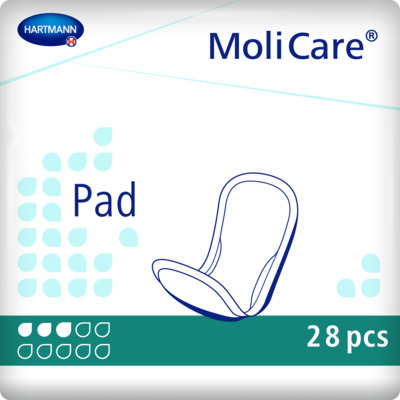Incontinence Advice
What Is Stress Incontinence?
Do you find yourself holding back a cough or laugh to avoid those small, yet embarrassing leaks? Stress incontinence can make even the simplest activities feel overwhelming, but there's no need to worry. Whether it's heavy lifting, coughing, laughing, or intimate moments, you can regain control and live life to the fullest.
Discover the secrets to successful stress incontinence management and the helpful solutions available to you. Embrace confidence and say hello to a worry-free life. Find out more now!

What Is Stress Incontinence?
Stress incontinence occurs when activities that put pressure on the bladder, such as coughing or laughing, lead to urine leakage. Of course, there are other forms of incontinence that are linked to stress.
Urgency Incontinence: Marked by a sudden, intense need to urinate, often followed by immediate leakage.
Overflow incontinence: Also known as chronic urinary retention, happens when the bladder doesn't empty completely, resulting in frequent, small leaks.
Total Incontinence: This refers to a complete inability to store urine in the bladder, leading to constant or recurrent leakage. Many individuals experience a combination of stress and urgency incontinence.
Here is our advice regarding how to stop urine leakage when coughing.
Products for women
Take a look at our incontinence products for women
Seeking Medical Help
Understanding the symptoms of stress incontinence is crucial. If you're experiencing any form of this condition, consulting a healthcare professional is strongly advised. Discussing urinary incontinence may feel uncomfortable, but it's a necessary step towards effective management.
Diagnosis typically begins with a detailed consultation with a healthcare provider, who may perform a pelvic or rectal examination and suggest maintaining a diary to track fluid intake and urination patterns. Depending on the case, referral to a specialist for further evaluation might be recommended.
Causes of Stress Incontinence:
As mentioned, stress incontinence arises due to the weakening of the pelvic floor muscles and the urinary sphincter, both crucial in supporting the urethra and controlling urine release. As the bladder fills, it enlarges, and normally, the urethra's valve-like muscles stay shut, holding urine until an appropriate time. However, weakened muscles may fail to contain urine during abdominal and pelvic pressure caused by actions like sneezing, bending, lifting, or intense laughter.
Key reasons for the pelvic floor muscles weakening could include:
- Childbirth: For women, childbirth can result in tissue or nerve damage, weakening the pelvic floor muscles or the sphincter. The onset of stress incontinence may be immediate post-delivery or emerge years later. Therefore, it's important to know about pregnancy and incontinence.
-
Prostate Surgery: In men, stress incontinence often stems from prostatectomy, the removal of the prostate gland, which can impair the sphincter located just beneath the prostate, encircling the urethra. Knowing about incontinence after prostate surgery and other relevant prostate problems can aid in making you more aware of this issue.
- Ongoing heavy work that places the lower abdomen under strain.
-
Chronic constipation associated with bearing down too hard.
- Hormonal deficiencies during menopause ( read here more about symptoms of the perimenopause).
-
Constitutional connective tissue weakness.
-
Obesity.
- General muscle atrophy in age.
- Surgery on the lower abdomen.
-
Uterine or vaginal prolapse.
Contributing Factors:
Additional elements that can exacerbate stress incontinence are:
Persistent coughing due to chronic illnesses.
Obesity.
- Smoking, which can lead to chronic coughing.
- Long-term participation in high-impact activities like running and jumping.
Stress Incontinence: Severity Levels
There are three different stages of severity with stress incontinence with the loss of urine, as follows:
-
Stage 1: Caused by physical exertion, the symptoms occur with high pressure in the abdominal cavity, leading to a loss of urine, for example, when coughing, laughing or sneezing.
-
Stage 2: When losing urine occurs with ongoing stresses such as standing up, sitting down, going up stairs, walking or jumping.
-
Stage 3: When urine is lost without physical exertion, when lying or sitting down.
Symptoms of Stress Incontinence:
Those with stress incontinence might experience urine leakage during activities that increase pressure on the bladder, such as:
Coughing or sneezing.
Laughing.
Bending over.
Lifting heavy objects.
During sexual activity.
Engaging in physical exercise.
It's important to note that leakage may not occur every time these activities are performed. However, any action that pressures the bladder, especially when it is full, can increase the likelihood of involuntary urine loss. For those that are more active, you can still participate in sports with incontinence.
Risk Factors:
Several risk factors can elevate the likelihood of developing stress incontinence, including:
Ageing: With the increase of age, factors such as muscle weakening, may heighten the susceptibility to stress incontinence. This condition is not confined to older adults, as younger people can also experience episodes.
Childbirth Method: The risk of stress incontinence is notably higher in women who have undergone vaginal childbirth, particularly with the use of forceps. However, women who have had vacuum-assisted deliveries do not seem to have an increased risk compared to caesarean deliveries.
- Body Weight: Overweight or obese people face a heightened risk due to the additional pressure exerted on abdominal and pelvic organs.
- Previous Pelvic Surgeries: In women, procedures like hysterectomy, and in men, surgeries addressing prostate cancer, can weaken bladder and urethra supporting muscles, thereby elevating stress incontinence risk.
Complications Associated with Stress Incontinence:
The implications of stress incontinence extend beyond physical symptoms and include:
Emotional Impact: The discomfort and embarrassment caused by stress incontinence can profoundly affect daily life, including work, social interactions, personal relationships, and sexual activities.
Mixed Incontinence: It is common for people to experience both stress incontinence and urgency incontinence, a condition where bladder muscle contractions lead to a sudden need to urinate.
Skin Issues: Continuous contact with urine can lead to skin irritation or sores, particularly in cases of severe incontinence. Protective measures like barrier creams or incontinence products are crucial to prevent such complications. Learn more about what are barrier creams now.
How To Prevent Stress Incontinence
While stress incontinence cannot always be prevented, there are proactive steps to potentially reduce its occurrence.
These methods include:
- Sustaining a healthy body weight.
- Modifying drinking habits, such as reducing alcohol intake.
- Engaging in pelvic floor muscle strengthening exercises.
Maintaining a Healthy Weight:
Obesity is a well-known risk factor for stress and urinary incontinence. Reducing this risk may be possible through regular physical activity and a balanced diet. To determine if your weight aligns with healthy standards for your height, consider using a healthy weight calculator.
Drinking Habits:
A healthcare professional can provide personalised advice on fluid intake based on your specific bladder condition. For those with stress incontinence, it's advisable to limit alcohol and caffeine-rich beverages like tea, coffee, and cola, as they can increase urine production and irritate the bladder. The advised weekly alcohol consumption limit stands at 14 units, with one unit equating to approximately half a pint of standard strength lager or a 25ml measure of spirits. Check out our recommendations for the best bladder-friendly drinks as well as foods and drinks that irritate the bladder.
Learn more about alcohol units and their implications.
Reducing fluid intake in the evening can help with nocturnal enuresis (frequent nighttime urination), but ensure adequate hydration throughout the day.
Pelvic Floor Exercises:
Pregnancy and childbirth can weaken the muscles controlling urine flow. Pregnant women can benefit from pelvic floor exercises to prevent urinary and stress incontinence.
Strengthening pelvic floor muscles is beneficial for everyone, not just those who are pregnant. Regular pelvic floor exercises can contribute to improved bladder control.
Treating Stress Incontinence
There are several methods to treat stress incontinence, both surgical and non-surgical.
Non-Surgical Methods:
Initially, healthcare professionals may recommend exploring basic measures to mitigate symptoms. These methods include:
-
Lifestyle modifications, such as weight loss and reducing intake of caffeine and alcohol.
-
Pelvic floor muscle training, which involves strengthening these muscles through specific exercises. Here are some pelvic floor exercises for women.
-
Bladder training techniques, aimed at increasing the duration between feeling the need to urinate and the actual act of urination.
-
Additionally, the use of incontinence products like absorbent pads may be beneficial. If these methods prove insufficient, medication might be advised as a further step.
Surgical Options:
In cases where non-surgical methods are inadequate, surgery may be considered, depending on the type of incontinence. For stress incontinence, surgical options such as sling procedures are available to alleviate bladder pressure or bolster the muscles responsible for urination.
Surgical interventions for urge incontinence may involve procedures to expand the bladder's capacity or the implantation of devices that stimulate the nerves controlling the detrusor muscles, which play a crucial role in bladder function.
In conclusion, understanding and managing urinary incontinence, particularly stress incontinence, is essential for improving quality of life. Preventative measures like maintaining a healthy weight, moderating fluid intake, and strengthening pelvic floor muscles play a pivotal role in mitigating the risk of stress incontinence. By embracing these professional approved methods, you can navigate the challenges of urinary and stress incontinence with greater confidence and control, leading to a more comfortable and fulfilling life.
FAQs
What is the most common cause of stress incontinence in women?
The most common cause of stress incontinence in women is childbirth, which can lead to weakened pelvic floor muscles and nerves, affecting bladder control.
Can stress incontinence be fixed?
Yes, stress incontinence can often be improved or fixed. Treatments include lifestyle changes, pelvic floor exercises, bladder training, medications, and in some cases, surgical procedures.
What is the new treatment for stress urinary incontinence?
A relatively new treatment for stress urinary incontinence is the use of bulking agents injected into the urethra, and in some cases, innovative nerve stimulation therapies and advanced minimally invasive surgical techniques. However, the availability and appropriateness of these treatments depend on individual cases and advancements in medical technology.
Sources:
NHS. (2023) Calculate Your BMI. [online] Available at: https://www.nhs.uk/health-assessment-tools/calculate-your-body-mass-index/ [accessed 26/01/24]
Alcohol Change. (2019) Alcohol Units. [online] Available at: https://alcoholchange.org.uk/alcohol-facts/interactive-tools/check-your-drinking/alcohol-units [accessed 26/01/24]
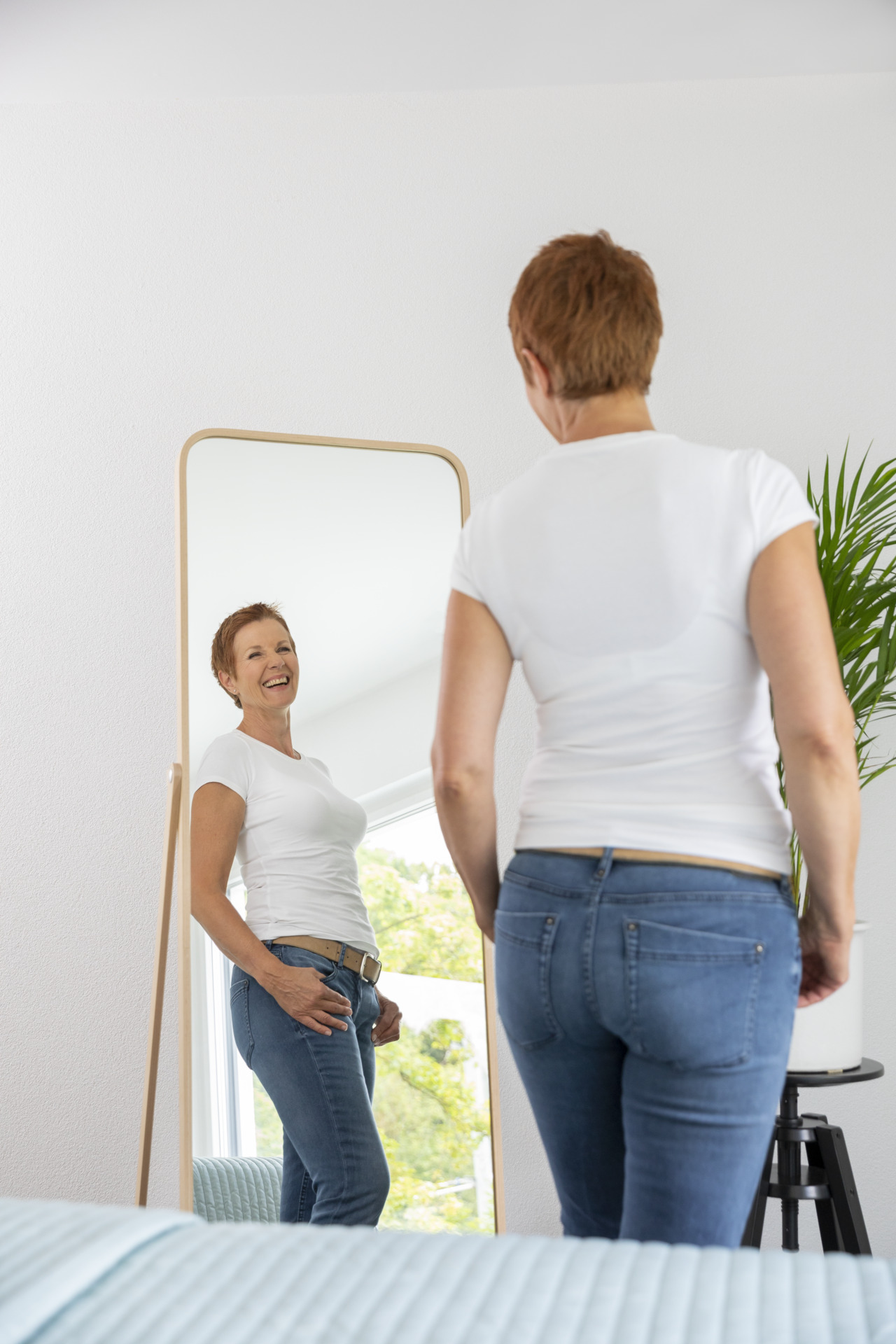
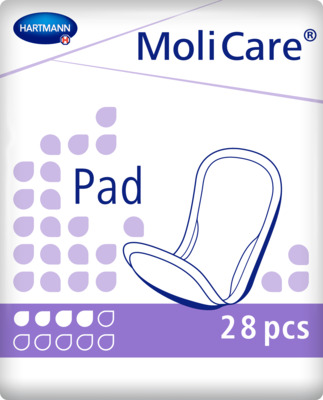
MoliCare Pad 4 Drops
<h2>Handy MoliCare Pad 4 Drops to Carry on the Go</h2> <p>Our MoliCare® Pad 4 Drops are an essential product for those experiencing slight incontinence, allowing you to regain control and live your busy and active life without the interference of bladder weakness. Designed for both men and women, this pad for men and women offers exceptional dryness and protection, ensuring your comfort and confidence.</p> <h2>‘Barely There’ Reassurance and Reliability</h2> <p>The MoliCare® Pad 4 Drops are slimline, discreet, and adjusted to fit your body seamlessly. It fixes securely inside your underwear, providing a ‘barely there’ comfort feel. With its soft and skin-kind fabric, along with a wide adhesive fixing strip on the backsheet, you can go about your day with the assurance of being protected against leakages.</p> <p>The absorbent core effectively prevents your skin from becoming too moist, while the elastic anti-leak edging adds an extra layer of security and peace of mind. Say goodbye to any worries about odours, as the MoliCare® Pad 4 Drops also neutralises odours to keep you fresh and confident throughout the day. Don't let incontinence hold you back from living life to the fullest.</p> <p>Ordering your MoliCare® Pad 4 Drops is hassle-free, as we offer fast and discreet delivery direct to your door. With our price match promise, you can trust that you're getting the best value for your money. Plus, enjoy free delivery on all orders over £40.</p> <p>If you need assistance in finding the perfect incontinence product for your needs, our friendly customer care team is here to help. Don't hesitate to reach out to us at 0800 028 9470. Take control of your life with the reliable protection and comfort of the MoliCare® Pad, alongside other <a href="https://www.hartmanndirect.co.uk/incontinence-products/incontinence-pads" style="color:#0563c1; text-decoration:underline">incontinence pads</a>.</p> <p> </p>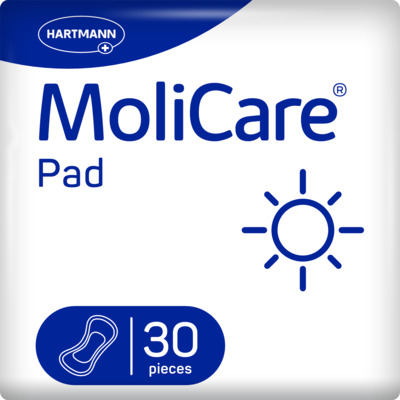
MoliCare Pads for Day
<h3>Incontinence pads for protection during the day </h3> <p>Even slight bladder weakness can be a burden in everyday life. There is a simple and affordable solution for this: MoliCare® Pad Day delivers discreet, reliable protection that helps you manage life’s daily challenges. </p> <p>The highly absorbent core inside the incontinence pads quickly locks away urine to ensure a pleasantly dry feeling on the skin. At the same time, it neutralises unpleasant odours. </p> <p>MoliCare® Pad Day are designed for discreet protection during the day. You can recognise the daytime incontinence product by the sun symbol on the packaging. They complement MoliCare® Pad Night incontinence pads which provide reliable protection at night. </p> <h3>Who is MoliCare® Pad Day suitable for? </h3> <p>MoliCare® Pad Day incontinence pads are suitable for people with mild bladder weakness. They leak anywhere from a few drops to 100 ml of urine between visits to the toilet. </p> <p>Incontinence pads are suitable for active women and men users whose mobility is not restricted. They can go to the toilet independently and without assistance. </p> <h3>Cheap incontinence products: comfortable, discreet protection </h3> <p>The incontinence pads have a highly absorbent core and odour control to keep you feeling fresh and comfortable. Thin and flexible, MoliCare® Pad Day are designed to be discreet, invisible under your clothing. Thanks to the wide adhesive strip, they remain securely in place even during sport. The incontinence pads are made from soft, breathable material so you feel comfortable all day. </p> <p>You usually need no more than two MoliCare® Pad Day incontinence pads during the day and one MoliCare® Pad Night incontinence pad for undisturbed sleep. This gives you a low cost yet high-quality round-the-clock supply of incontinence pads from HARTMANN. </p> <h3>We are HARTMANN </h3> <p>MoliCare® is HARTMANN’s extensive range of continence care. For over 40 years, we have been developing effective, reliable products that help people manage the challenges of living with incontinence. Our aim is to provide the right solution for every need. </p>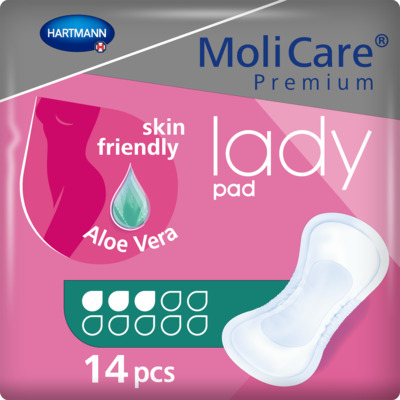
MoliCare® Premium Lady Pad 3 Drops
<h2>Lightweight Incontinence Solutions</h2> <p>The MoliCare® Premium Lady Pad 3 Drops is the perfect solution for women who are looking for a slim, discreet and comfortable way to manage slight bladder incontinence situations. The pad is small and lightweight, so it's easy to carry with you on the go. And the odour neutralisers help to keep you feeling fresh and confident all day long.</p> <p>With a fast and reliable delivery, you can apply your MoliCare® Premium Lady Pad 3 drops in next to no time. With their compact appearance, they are easy to apply and are barely noticeable when fitted under your underwear. For extra skin-friendly protection, we equip these products with Aloe Vera to maintain a healthy skin, as well as absorbent and secure technology. It is truly one-size fits all with this range!</p> <h2>Maintain peace of mind</h2> <p>These lady pads contain 14 pieces per bag, are set at an affordable pricing, and will prevent leakages, maintaining peace of mind in all social situations.</p> <p>If you require additional information, do not hesitate to get in touch with our reliable customer service team, who are ready on hand to answer your questions. If you're looking for a reliable pad that will help you stay dry and comfortable, the MoliCare® Premium Lady Pad 3 Drops is a great option. Order yours today!</p>